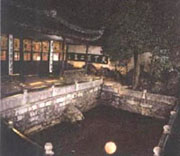Huishan Spring
The Huishan Temple is located in the Xihui Park at the foot of the Huishan Hill in western suburb of Wuxi City, Jiangsu Province. Huishan Hill, also known as Huiquanshan Hill (Hui Spring Hill), is also called Nine Dragon Hill because it has nine mountain ridges, looking like a moving dragon. The Huishan Hill is reputed as the first hill south of the Yangtze River.
 The Huishan Hill is famous for its springs, among which the most famous one is the second spring under heaven. This spring is divided into three pools: the upper pool, the middle pool and the lower pool. The lower pool is at the entrance, dug in the Song Dynasty (960-1279), with water flowing down from a hole above and then out of the mouth of a stone dragon to the ground. A hall named Qilan (ripples and billows) Hall stands beside the spring, with a Kwan-yin stone erected in front of it. During the reign of Emperor Qianlong of the Qing Dynasty (1644-1911), the stone was moved here from the villa of Gu Kexue, a senior official of the Ming Dynasty (1368-1644). In the back of the hall is the well-known Erquan Pavilion. The upper pool and the middle pool situate inside and in front of the pavilion respectively, dug during late Dali year (779) of the Tang Dynasty (618-907). The upper pool has an octagonal shape, with the best water quality among the three pools. The middle pool has a shape of asymmetrical square, with its water seeping though the Ruobing Hole. According to legend, the pool was discovered by a monk named
The Huishan Hill is famous for its springs, among which the most famous one is the second spring under heaven. This spring is divided into three pools: the upper pool, the middle pool and the lower pool. The lower pool is at the entrance, dug in the Song Dynasty (960-1279), with water flowing down from a hole above and then out of the mouth of a stone dragon to the ground. A hall named Qilan (ripples and billows) Hall stands beside the spring, with a Kwan-yin stone erected in front of it. During the reign of Emperor Qianlong of the Qing Dynasty (1644-1911), the stone was moved here from the villa of Gu Kexue, a senior official of the Ming Dynasty (1368-1644). In the back of the hall is the well-known Erquan Pavilion. The upper pool and the middle pool situate inside and in front of the pavilion respectively, dug during late Dali year (779) of the Tang Dynasty (618-907). The upper pool has an octagonal shape, with the best water quality among the three pools. The middle pool has a shape of asymmetrical square, with its water seeping though the Ruobing Hole. According to legend, the pool was discovered by a monk named  Ruobing in the Tang Dynasty, hence the name Bing Spring.
Ruobing in the Tang Dynasty, hence the name Bing Spring.
Engraved on the walls of the Erquan Pavilion and the Qilan Hall are stone inscriptions written by calligrapher Zhao Meng of the Yuan Dynasty (1271-1368) and Wang Shu of the Qing Dynasty (1644-1911) respectively. The inscriptions read Tian Xia Di Er Quan (the second spring under heaven).
The sweet and clear Huishan Spring water has been tasted and appreciated since the day it was discovered. Lu Yu, a tea expert in the Tang Dynasty, went to Wuxi several times. After an on-the-spot investigation in the Huishan Hill, he wrote an article The Notes on Huishan Temple. Through the ages, numerous emperors, high-ranking officials, poets and writers came to drink the Erquan water and wrote poems and songs about the Erquan. Emperor Huizong of the Song Dynasty even ranked the Erquan water into articles of tribute.
Source: http://www.chinaculture.org